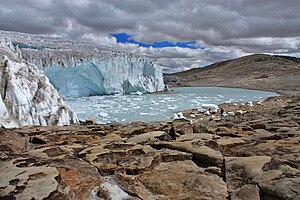Quelccaya ice cap
| Quelccaya ice cap | ||
|---|---|---|
|
Quelccaya ice cap |
||
| location | Peru | |
| Mountains | Cordillera de Vilcanota ( Andes ) | |
| surface | 44 km² | |
| Coordinates | 13 ° 56 ′ 0 ″ S , 70 ° 50 ′ 0 ″ W | |
|
|
||
|
Retreat of the glacier from 1975 to 2000 |
||
At a little less than 44 square kilometers in 2018, the Quelccaya Ice Cap is considered the second largest tropical ice field in the world.
The glacier is located in the Cordillera de Vilcanota in southern Peru .
The glacier massif limits the catchment area of Lake Titicaca to the northwest. The massif and the northern shore of the lake are about 160 km apart as the crow flies.
threat
The ice cap had an area of just under 44 km² in 2018. In the 1970s it was still the largest tropical glacier area on earth with a size of more than 70 km², but until the end of the 2010s it melted faster than the ice cap of Coropuna, also located in Peru, and is now slightly smaller than it. The edges of the Quelccaya Ice Cap were (2018) on average 5300 m high, at its highest point it reached about 5680 m . Between 1980 and 2010, 0.57 (± 0.10) km², a total of almost a third of the glacier area, was lost every year, with an increasing rate of loss.
The Qori Kalis Glacier is the main outlet glacier of the Quelccaya Ice Cap. Its retreat rate was around 60 meters a year around 2010. This means an increase of ten times compared to the period 1963–1978. In the years 2000–2002, after a pronounced El Niño event , according to data from the US paleoclimatologist Lonnie G. Thompson , it was shortened by annually. 200 m. The scientist feared that the Qori Kalis Glacier might have disappeared as early as 2012.
While no changes in precipitation were observed in the region, temperatures have been increasing since the middle of the 20th century. In addition to man-made global warming , fluctuations in the Pacific Decade Oscillation over several decades and, in individual years, the El Niño-Southern Oscillation also play a role. The water runoff fed by the ice cap will decrease significantly in the future during the dry season.
fauna
A special feature of the glacier is that the mirror diuka ( Diuca speculifera ) builds its nest in this glacier. This makes its breeding ground among the highest in the western hemisphere, if not in the world. For a long time only the emperor penguin ( Aptenodytes forsteri ) was known to breed regularly in the glacier. Reports from 1988 when kittiwakes ( Rissa tridactyla ) built their nests on glaciers in Prince William Sound were due to unusual circumstances that year.
Individual evidence
- ↑ US, Geological Survay Glaciers of Perú (Eng.)
- ↑ Albrecht Kessler on the reconstruction of Lake Titicaca levels from the 19th century with the help of an ice core from the Quelccaya Glacier (PDF; 1.1 MB)
- ↑ Amy Moran, Christopher Shuman: Peru's Shrinking Tropical Ice Caps. NASA's Goddard Space Flight Center, December 14, 2018, accessed October 15, 2019 .
- ↑ a b c M. N. Hanshaw, B. Bookhagen: Glacial areas, lake areas, and snow lines from 1975 to 2012: status of the Cordillera Vilcanota, including the Quelccaya Ice Cap, northern central Andes, Peru . In: The Cryosphere . March 2014, doi : 10.5194 / tc-8-359-2014 .
- ↑ a b c d Christian Yarleque, Mathias Vuille, Douglas R. Hardy, Oliver Elison Timm, Jorge De la Cruz, Hugo Ramos, Antoine Rabatel: Projections of the future disappearance of the Quelccaya Ice Cap in the Central Andes . In: Scientific Reports . October 2018, doi : 10.1038 / s41598-018-33698-z .
- ↑ The Ice Plant Cometh. In: Americam Museum of Natural History. Retrieved October 15, 2019 .
- ↑ Mongabay Peru's largest glacier is melting quickly ( Memento from September 10, 2007 in the Internet Archive )
- ↑ Wilson Journal of Ornithology White-winged Diuca Finch (Diuca speculifera) Nesting on Quelccaya Ice Cap, Perú (Eng.)


